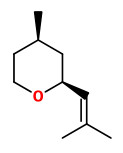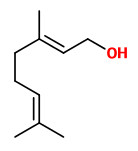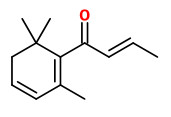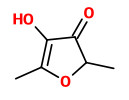Litchi chinensis Sonn. - syn.Nephelium litchi Cambess. - Sapindaceae - 荔枝 lìzhī (chin.), leechee , lychee, Litchi
Evergreen tree, up to 10m tall, native to tropical Southeast Asia, cultivated as fruit plant; bark grayish black; branches brownish red; leaves with petiole up to 25cm long, leaflets 2-4 pairs, adaxially deep green and shiny, lanceolate or ovate-lanceolate; inflorescences terminal, large, many branched, calyx golden tomentose; fruit dark red to fresh red when mature, globose to subglobose, 2-4cm; seeds covered by fleshy arillode with floral smell and sweet flavor.
http://www.efloras.org/florataxon.aspx?flora_id=2&taxon_id=200013205
„GC/O analysis detected at least 60 odor-active volatiles in the fruit extract. More odor-active volatiles were detected in the ethyl acetate extract than in the nonpolar Freon extract. Among the compounds that had significant odor activity, geraniol, guaiacol, vanillin, 2-acetyl-2-thiazoline, 2-phenylethanol, unknown (58), (Z)-2-nonenal, β-damascenone, 1-octen-3-ol, furaneol, and linalool were found to be the most odor-active. On the basis of their calculated odor activity values (OAV), isobutyl acetate, guaiacol, cis-rose oxide, 2-acetyl-2-thiazoline, β-damascenone, furaneol, linalool, (E)-2-nonenal, geraniol, and isovaleric acid were determined to significantly contribute to the aroma of this fruit. GC/O analysis confirmed that 2-phenylethanol was probably responsible for the floral character and that the citrus-fruity aroma is due to the presence of many odor-active terpenes, particularly geraniol. Although cis-rose oxide was only 30% as active in GC/O as the most potent odor, its high OAV indicates its importance to the character of lychee odor. An unknown sesquiterpene-like compound (58), with a lychee-like odor characteristic of the fresh fruit, was identified by GC/O as being a highly odor potent compound. Taken together, the aroma of lychee was determined to be due to the interaction between compounds with floral, nutty, citrus, and fruity aromas. “
[Gas chromatography/olfactory analysis of lychee (Litchi chinesis Sonn.)., Ong, P.K., Acree, T.E., Journal of Agricultural and Food Chemistry, 46(6), 1998, 2282-2286]
„GC/O analysis of canned lychees indicated that cis-rose oxide, linalool, ethyl isohexanoate, geraniol, furaneol, vanillin, (E)-2-nonenal, β-damascenone, isovaleric acid, and (E)-furan linalool oxide were the most odor potent compounds detected in the fruit extracts. However, on the basis of calculated odor activity values (OAVs), cis-rose oxide, β-damascenone, linalool, furaneol, ethyl isobutyrate, (E)-2-nonenal, ethyl isohexanoate, geraniol, and δ-decalactone were determined to be the main contributors of canned lychee aroma. When these results were compared with GC/O results of fresh lychees and Gewürztraminer wine, 12 common odor-active volatile compounds were found in all three products.“
[Similarities in the aroma chemistry of Gewürztraminer variety wines and lychee (Litchi chinesis Sonn.) fruit. Ong, P. K., Acree, T. E., Journal of agricultural and food chemistry, Vol.47(2), 1999, 665-670]
„Free and glycosidically-bound volatile compounds were isolated and separated from fresh clear lychee juice … In the free fraction (2907 mg/kg), the major volatile compounds found were acetoin (30.1%), geraniol (15.6%), 3-methyl-2-buten-1-ol (15.3%), octanoic acid (7.28%), 2-phenylethanol (4.91%), cis-ocimene (4.32%), and butyric acid (3.40%). In the bound fraction (1576 mg/kg), the latent major volatile compounds found were geraniol (73.7%) and geranial (7.95%). In aroma evaluation, the free volatile fraction showed a fresh-fruity, lychee-like aroma whereas the bound fraction was odourless. The characteristic lychee-like aroma was noted in the bound fraction after enzymatic hydrolysis. On combination of the free and hydrolysed bound fractions, a strongly fruity, lychee-like aroma was perceived.“
[Free and glycosidically bound aroma compounds in lychee (Litchi chinensis Sonn.)., Chyau, C.C., Ko, P.T., Chang, C.H., Mau, J.L., Food Chemistry, 80(3), 2003, 387-392]
24 odor volatiles were common to all of the three cultivars Mauritius, Brewster, and Hak Ip: Acetaldehyde, ethanol, ethyl-3-methylbutanoate, diethyl disulfide, 2-methyl thiazole, 1-octen-3-one, cis-rose oxide, hexanol, dimethyl trisulfide, α-thujone, methional, 2-ethyl hexanol, citronellal, (E)-2-nonenal, linalool, octanol, (E,Z)-2,6-nonadienal, menthol, 2-acetyl-2-thiazoline, (E,E)-2,4-nonadienal, β-damascenone, 2-phenylethanol, β-ionone, and 4-vinyl-guaiacol.
[Mahattanatawee, Kanjana, et al. „Comparison of three lychee cultivar odor profiles using gas chromatography- olfactometry and gas chromatography-sulfur detection.“ Journal of Agricultural and Food Chemistry 55.5 (2007): 1939-1944]
„Volatile components of nine litchi cultivars (10 samples) with high commercial value from Southern China were investigated by means of gas chromatography−mass spectrometry combined with headspace solid phase microextraction. A total of 96 volatiles were detected, of which 43 were identified. Seventeen common volatiles in all the samples included linalool, cis-rose oxide, α-terpineol, β-citronellol, geraniol, p-cymene, ethanol, 3-methyl-3-buten-1-ol, 3-methyl-2-buten-1-ol, 1-hexanol, (E)-2-hexen-1-ol, 2-ethyl-1-hexanol, 1-octen-3-ol, 1-octanol, ethyl acetate, p,α-dimethylstyrene and 3-tert-butyl-4-hydroxyanisole. Although the volatile composition and concentration varied between these cultivars, the components with the highest OAVs in most cultivars were still cis-rose oxide, trans-rose oxide, 1-octen-3-ol, and geraniol.“
[Comparison of volatile profiles of nine litchi (Litchi chinensis Sonn.) cultivars from Southern China., Wu, Y., Pan, Q., Qu, W., Duan, C., Journal of agricultural and food chemistry, 57(20), 2009, 9676-9681]
Volatile compounds in ‘Sweetheart’ lychee were examined using gas chromatography-olfactometry/mass spectrometry (GC-O/MS). Solvent assisted flavor evaporation (SAFE) technique was used to identify the aroma-active compounds in lychee. Further characterization of the most important odorants in ‘Sweetheart’ lychee was achieved using aroma extract dilution analysis (AEDA). Thirty-one key aroma-active odorants were identified in the flavor dilution (FD) factor range of 2-1024. Methional (cooked potato) and geraniol (sweet, floral) exhibited the highest FD factors of 1024 and 512, respectively, these were followed by furaneol (sweet, caramel), nerol (floral, sweet), dimethyl trisulfide (DMTS) (preserved vegetable, sulfury), linalool (floral), (E,Z)-2,6 nonadienal (cucumber) and nerolidol (metalic, sesame oil). Furthermore, the flavor profile of ‘Sweetheart’ lychee was described by sensory analysis. Floral, tropical fruit, peach/apricot and honey were scored with relatively high scores for each aroma attribute. The sweetness rating was the highest score among all the attributes.
[Feng, Shi, et al. „Characterization of key aroma-active compounds in lychee (Litchi chinensis Sonn.).“ journal of food and drug analysis 26.2 (2018): 497-503]
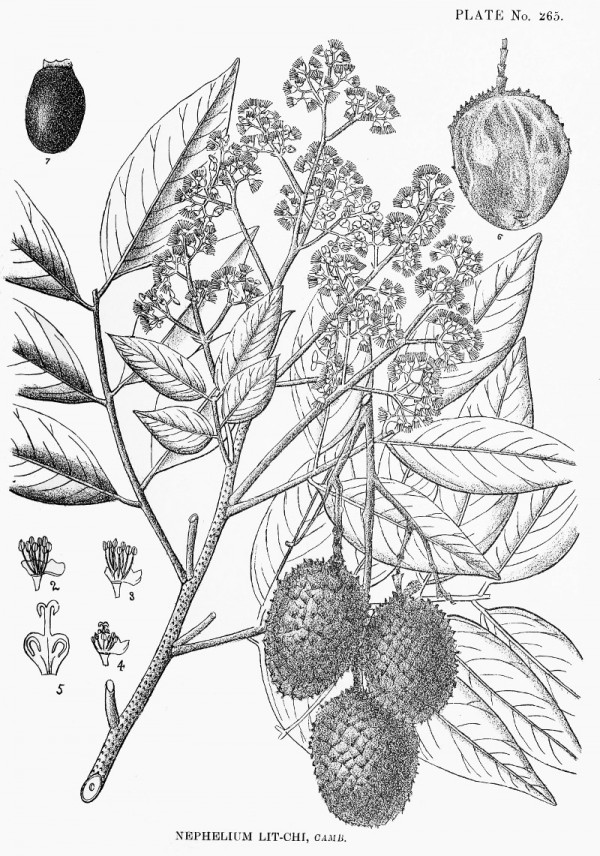
Kirtikar, K.R., Basu, B.D., Indian medicinal plants, Plates, vol.2 t.265 (1918)
http://plantgenera.org/species.php?id_species=611834
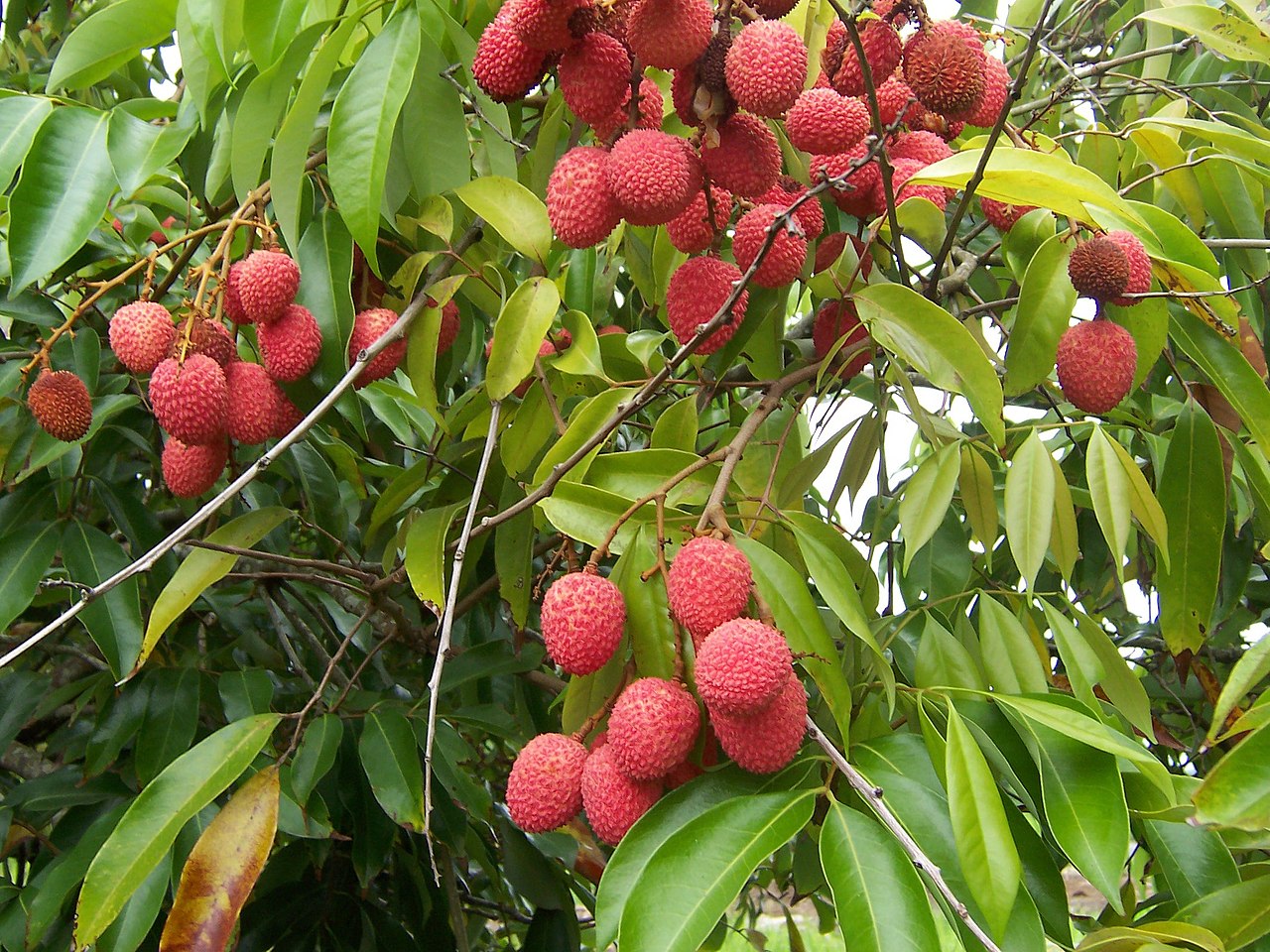
Lychees (Litchi chinensis), picture taken at Saint-Benoît/Réunion island (2006)
Author: B.navez CC BY-SA 3.0 Wikimedia Commons

